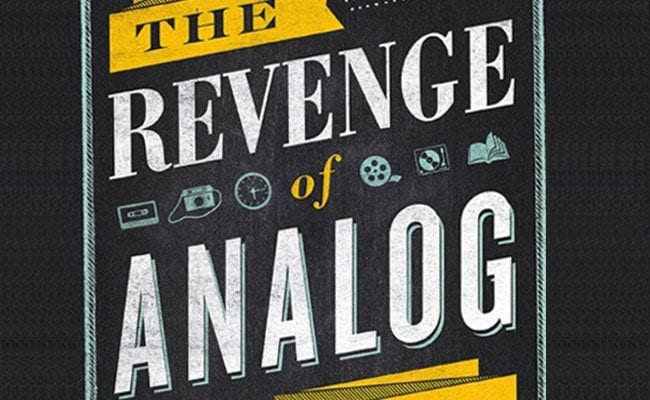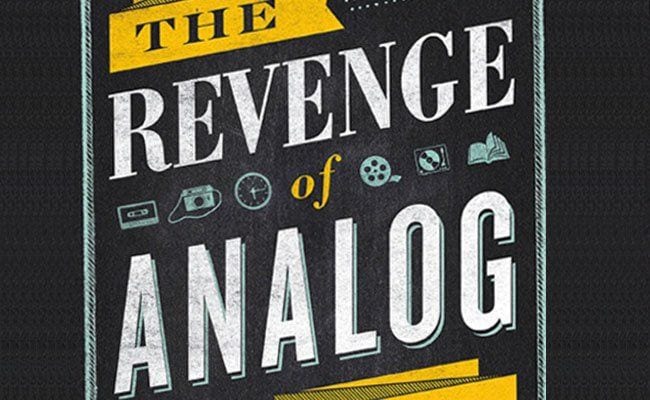
Is digital dead?
Well, no. But the more important news is that analog is back.
Of course it never really left. But news of its death was greatly exaggerated by those who presumed that all things analog would naturally be replaced by new things digital, and that a better happier cleaner faster nicer more productive world would inevitably result.
Neither has happened. Many of digital’s promises backfired — from virtual education to e-readers — and reliance on digital has actually led to a decrease in creativity, innovation and efficiency in many fields, studies now show. Of course, much good has come from digital — tremendous technological innovations that have improved many aspects of our lives — but the challenge has been learning to balance the pros and cons of both the analog and digital dimensions of modern life.
It’s tempting to say ‘analog and digital realities’, but that’s the point: there is only one reality, and it’s analog. Increasingly, innovators in a range of fields are starting to recognize this, argues David Sax in a fascinating new survey of analog’s revenge.
Just as the early digital pioneers were the great beneficiaries of the e-goldrush, those who recognized the latent value of analog are also achieving unexpected success, and Sax explores their experiences and stories. From the creators of Moleskine notebooks to the founder of the back-to-basics, made-in-Detroit Shinola watch brand, more and more creators are realizing that people value the very qualities digital was supposed to supplant: tactile, hand-made, simple objects. In a world where technology offers seemingly limitless options, it’s the constraints of analog products, coupled with their simplicity and instant, universal usability, which seem to do so much better at channelling creativity, innovation, and satisfaction. That’s been the observation of architects, designers, coders, and even the engineers and teachers who refused to allow their beloved whiteboards to be replaced by smartscreens.
The point, argues Sax, is not to reject technology, but to understand its limitations and the fact that technological progress does not automatically lead to improvement in the human endeavors to which it is applied. The most successful designers, it seems, are learning how to blend digital and analog. Moleskine, among other stationary companies, are partnering with digital and cloud computing companies to forge links between analog products and digital systems. Engineers learned to integrate small digital screens into larger, analog whiteboards. It’s no longer an all-or-nothing game, but rather a more complicated trial-and-error project of learning which digital possibilities will work with which analog realities.
The key point underscored by Sax’s broad-ranging study is that the world is analog, and it’s not going anywhere. Older generations of analog holdouts may take some vengeful glee in the knowledge that the vinyl record industry is booming once more, that analog film photography production techniques are being relearnt after nearly being lost to posterity, and that board games are experiencing a florescence beyond anything they or their parents’ and grandparents’ generations experienced.
Likewise, many schoolteachers may smirk at the fact that whiteboards have triumphed in the classroom, and many professors would doubtless be relieved to learn that online learning and digital textbooks are beginning to look like the biggest dud since the Russian moon lander. However, Sax notes, it’s actually the younger generations — those brought up in a digital world — who are in fact demonstrating the greater ability to identify analog’s intrinsic value. They grew up surrounded by digital devices — tablets forced on them in kindergarten, screens instead of playgrounds — and while their ability to use them is second nature, they recognize that they’re nothing more than tools, intended to supplement, not replace, a fundamentally analog world.
It’s not curmudgeonly old hold-outs, but rather younger generations that drove the vinyl record resurgence; younger generations that got sick of lonely video games and eschewed them for the joy of sitting around a table playing board games. The analog world speaks to intrinsic human desires, argues Sax. People prefer vinyl records and paper books because they’re tactile: something to hold, to collect and stare at, to immerse oneself in without the distraction of digital interface. People have rediscovered board games because they facilitate and require social relationships. Sax notes that the rediscovery of analog play may have resulted in some ways from the success-to-excess of computer games. Video games in the ‘80s and ‘90s facilitated social relationships — kids crowded around a computer entangled with joysticks, or group hangouts at the games arcade — but the online gaming of today offers stunning virtual reality in lonely, socially alienated surroundings.
It’s the desire for social relationships that has also stymied online education, notes Sax (also the dismal success rates of e-learners). Online courses and e-learning is little more than Wikipedia with a university crest. Anyone can fill their heads with data, he notes; what people want is the discursive relationship of student and teacher which can only emerge from person-to-person engagement and classrooms full of fellow embodied students. This isn’t just sentimentality: studies show that information sitting on whiteboards and chalkboards is retained longer than digital data; that people who study in physical classrooms do much better than those who learn online.
In a similar vein, the success of artisan crafting, from Etsy to high-fashion brands like Shinola, reflects the fact that people value tradition-honed, handmade craft and production techniques. Industrial manufacturers assumed everyone would prefer the fastest, most accurate digital products manufactured under conditions of mass production that would render them inexpensive. Yet the success of growing numbers of analog manufacturers reveals that people are actually quite content to pay more for the ideas they value — simple-yet-durable, well-constructed handmade objects; locally-sourced materials. In many situations, people actually seem to prefer limited and constrained choices over limitless options. This is equally true in their consumption habits — preferring to browse a physical bookstore over shopping on Amazon — as in their use of technology (preferring a sketchbook or whiteboard over a tablet or smartscreen).
Educators, engineers, newspaper editors — they all fell for the notion that technological progress would automatically lead to greater things. The lure of technological progress is now being more critically questioned, amid data suggesting educational technology does not improve outcomes (perhaps the opposite), that hi-tech design isn’t always appreciated by end-users, and that print newspapers have almost universally wound up subsidizing their costly and unprofitable web iterations, despite initial swaggering expectations to the contrary. Digital start-ups can win big for investors, admits Sax, but they’re far more of a gamble than their analog counterparts, which tend to earn money more consistently and reliably, albeit more slowly.
Maybe, goes the counter-argument, we just haven’t worked out the correct digital models yet. Perhaps. But Sax, along with the growing cadre of innovators he draws on in his book, believe the revenge of analog demonstrates something deeper about the human condition: an analog identity that will never truly be supplanted, and which innovators in every field must learn to work with, not ignore or brush aside.
Sax is a business journalist, and he balances his analog ideas with plenty of digitally-sourced data. At times it comes at the book’s expense — the chapters on vinyl record resurgence and film photography are so densely packed that the industry data and technical details threaten to drown out his far more interesting conceptual arguments. While his arguments about the value of analog experience are well developed insofar as they apply to analog objects — books, journals, board games — he enters more complicated terrain when applying the arguments to broader fields of experience (work, education) which are shaped by more complex social dynamics.
Many of Sax’s analog innovators are capitalists whose desire for profit is tempered by a healthy respect for non-pecuniary values; but how much of a future do they really have to grow in a neoliberal world where ideas and values are increasingly legislated a distant second place to the profit motive? Sax vaguely acknowledges the implicit class bias of his book — acknowledges that analog products are, increasingly, sought-after luxury items — but how universal and impactful can the analog experience be if it remains isolated to a shrinking upper and middle class? To fully appreciate the role of analog in fields such as work and education, a fundamental — and in this book unanswered — question is, What lessons does the revenge of analog offer for a world characterized by growing precarity and inequality? Perhaps these trends help explain the broad desirability of analog, but what credible solutions can analog offer to the masses who can’t afford a Shinola watch or a Moleskine notebook?
Sax hints that the benefits lie in offering a locally-sourced, higher-quality counter-model to the outsourcing, low-quality-mass-production trend of transnational capitalism, but he also clearly admires the old-school ambition and drive of analog’s capitalist financiers. Shinola may have brought jobs to Detroit, but can low-pay, non-unionized employment actually rebuild a shattered economy? Or is it just a salve; low-cost labour for the rich boss and basic survival for the workforce? These are the sorts of issues that need fleshing out in greater detail if we are to really understand what long-term implications the revenge of analog might have for our world.
Perhaps only time will tell (preferably on big chunky chrome-and-glass watchfaces, affixed to elegant hand-made leather straps). Meanwhile, The Revenge of Analog will appeal both to principled Luddites as well as more sophisticated entrepreneurs seeking to navigate this more complicated, increasingly digitally-averse age. While much of the book is written toward an entrepreneurially-minded audience, its appeal is broad, and it’s the big ideas underlying the industry analysis which offer the greatest food for thought. Sax is a persuasive and eloquent interlocutor for the analog counter-revolution, and his work reveals that the true irony of the digital revolution may be that it has led us to more deeply value and appreciate our analog world.

